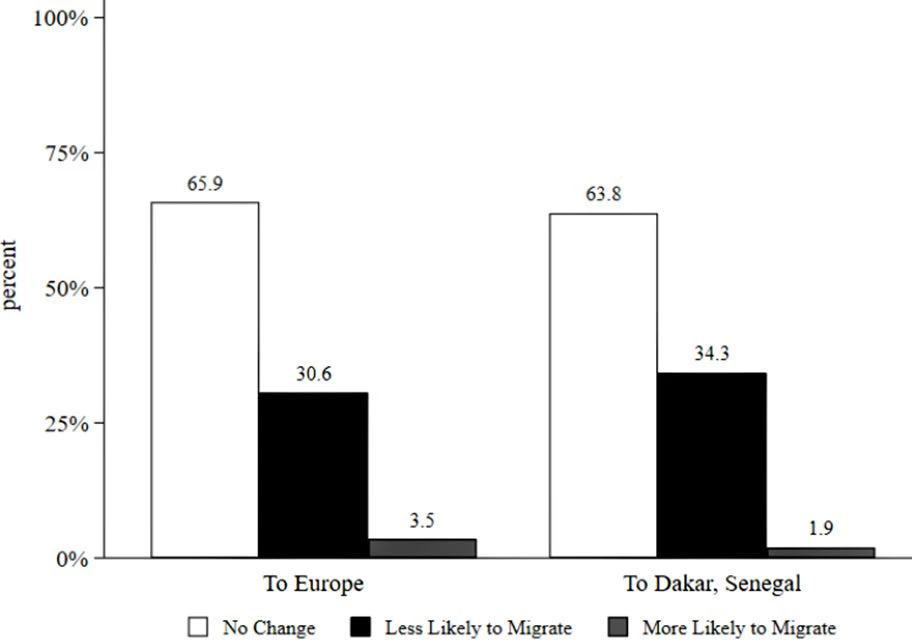 Letterbox view of silver pen lying at paper document. megaflopp / Shutterstock.com
Letterbox view of silver pen lying at paper document. megaflopp / Shutterstock.com
This blog is a biweekly feature highlighting recent working papers from around the World Bank Group that were published in the World Bank’s Policy Research Working Paper Series. This entry introduces eight papers published during the weeks of May 10 and 17 on various topics, the impact of COVID-19 on migrants in the Gambia, the benefits of adopting contactless payments during the pandemic, extreme weather events in Africa and mechanisms for coping with them, among others. Here are the highlights of select findings.
First, we feature two COVID-19 related papers; one examines the COVID-19 impact on migration patterns, while the other discusses the business resilience of adopting contactless payment during the pandemic. There is a growing concern that more people may turn to irregular migration under wide border closures during the pandemic. How Has COVID-19 Affected the Intention to Migrate via the Backway to Europe by Tijan L. Bah and coauthors examines the impact of COVID-19 on young Gambian males’ migration patterns to Europe and to neighboring Senegal. Digital Payments and Business Resilience by Youssouf Camara examines whether merchants with contactless payment technology are more resilient during the COVID-19 pandemic crisis than those without.
- How Has COVID-19 Affected the Intention to Migrate via the Backway to Europe: Using a large scale panel survey of Gambian households conducted in 2019 (pre-pandemic) and in 2020 (during the COVID-19 global pandemic), the authors report that the pandemic has reduced the intention to migrate to Europe for 30.6 percent of youth and to Senegal for 34.3 percent of youth (Figure 1). Further analysis shows that the desire to migrate decreased especially for two groups of individuals: those who were unsure about migrating pre-COVID-19 and poorer individuals who have liquidity constraints to cover migration costs.
Figure 1: Reported Effect of COVID-19 on Intention to Migrate to Europe and to Dakar (Adopted by Bah et al. 2021)
- Digital Payments and Business Resilience: Using a unique data set on card-sales transactions for all merchants in France from January 2019 to December 2020, the study shows that merchants with contactless payment technology increase their card-sales amounts on average by 8.3 percent compared with merchants without this technology. It also finds evidence that accepting contactless payments during the pandemic helps merchants attract more new consumers: the number of new customers increased by 9.7 percent per month for merchants with contactless technology.
Extreme weather events have been increasing across Africa, and smallholder farm households are disproportionally affected by such weather shocks. The next three papers demonstrate various impacts of these climate shocks and discuss formal and informal risk-coping mechanisms. Recurrent Climatic Shocks and Humanitarian Aid by Nancy McCarthy and coauthors estimates the impacts on household livelihoods of the consecutive extreme weather events (droughts and floods) that occurred in 2014-2016 in Malawi, and then assesses the effectiveness of humanitarian aid in mitigating these negative impacts. Climate Anomalies and International Migration by Fernanda Martínez Flores, Sveta Milusheva, and Arndt R. Reichert examines the effects of climate shocks on international migration from West Africa within the region and toward Europe. Lastly, as traditional institutions such as polygyny might work as an alternative risk coping mechanism against climate shocks, Polygyny and Farm Households’ Resilience to Climate Shocks by Sylvain Dessy and coauthors tests the hypothesis that polygynous communities are more resilient to the adverse impacts of drought.
- Recurrent Climatic Shocks and Humanitarian Aid: Results confirm that climate shocks have consistent negative impacts on a range of welfare outcomes, particularly for households that experienced sequential shocks. Although aid recipients can successfully mitigate the impact of shocks, authors underscore the geographic targeting errors of aid distribution; female-headed households, households that are composed of only elderly adults, and households with lower levels of wealth are shown to be more likely to receive aid. However, under a weather shock, wealth at a community level is no longer an effective criterion for aid receipts.
- Climate Anomalies and International Migration: The results show that drier soil conditions (i.e., a signals of a drought) decrease the probability of migration. Compared with normal soil moisture conditions, a standard deviation decrease in soil moisture leads to a 2 percentage point drop in the probability of migration, equivalent to a 25-percent decrease in the number of migrants. Moreover, the paper examined heterogeneity in migration decisions across income groups.
- Polygyny and Farm Households’ Resilience to Climate Shocks: Using data from rural Mali, authors show that polygyny enhances household resilience to adverse effects a year after the drought shock. Households living in more polygynous communes are more likely to sell livestock, access credit, hire labor, use improved seeds and chemical inputs, and diversify crop production than those living in less polygynous communes. The results suggest that the high prevalence of polygyny along the Sahel belt in Sub-Saharan Africa may serve as an alternative to formal risk management mechanisms.
Next, two papers shed lights on the biases of using household data to estimate individuals’ standards of living. Traditionally, poverty measures are based on consumption data for the household as a whole, rather than for individual members. Diamonds in the Rough? by Theophiline Bose-Dukerpresents and coauthors presents a theoretical model for estimating intra-household resource shares using household survey data. Then, the authors applied the model to estimate individual poverty levels using household surveys in Albania, Bulgaria, Bangladesh, and Malawi. Representativeness of Individual-Level Data in COVID-19 Phone Surveys by Joshua Brubaker, Talip Kilic, and Philip Wollburg assesses selection biases in individual-level analyses based on COVID-19 phone survey data.
- Diamonds in the Rough?: The results demonstrate substantial within-household consumption inequality and suggest an underestimation of poverty with the per capita approach. Applying a proposed model of intra-household resource shares, the authors reveal that women are poorer than men and that children and the elderly are disproportionately affected by poverty.
- Representativeness of Individual-Level Data in COVID-19 Phone Surveys: Comparing COVID-19 phone survey respondents with pre-COVID-19 face-to-face survey data, the authors demonstrate that phone survey respondents are significantly different from the general adult population. They are significantly more likely to be household heads or their spouses, and they tend to be older, more educated, and more likely to own a household enterprise. To improve the representativeness of individual-level phone survey data, the authors propose recalibrating the household-level phone survey sampling weights.
Finally, we introduce a paper, Expansionary Austerity by Bernardo Morais and coauthors, which examines how an introduction of ceilings on local public debt can increase economic activity. A Mexican financial discipline law enacted in 2016 established a ceiling on the rise of local governments’ indebtedness. The law placed larger constraints on states with higher debt.
- The analysis finds that states with ex-ante higher public debt have stronger economic growth after the implementation of the law. The mechanism behind the growth is a reduction in crowding out. In states with higher ex-ante public debt, banks reallocate credit away from local governments and into private firms, with strong positive firm-level real effects. Furthermore, the impact of the law on economic growth is stronger in states allocating a larger share of public spending to non-infrastructure projects.
The following are other interesting papers published during the past few weeks. Please check out these articles as well!
- What Are the Benefits of Government Assistance with Household Energy Bills? Evidence from Ukraine (Alberini and Umapathi)
- The Hidden Potential of Call Detail Records in The Gambia (Arai et al.)
- Gain without Pain? Non-Tariff Measures, Plants’ Productivity and Markups (Cali, Le Moglie, and Presidente)
- Automation and Manufacturing Performance in a Developing Country (Cali and Presidente)
- Firm-Level Adoption of Technologies in Senegal (Cirera et al.)
- Trade Impacts of Intellectual-Property-Related PTAs: Evidence from Using the World Bank Deep Trade Agreements Database (Maskus and Ridley)
- Does the Gender Wage Gap Influence Intimate Partner Violence in Brazil? Evidence from Administrative Health Data (Perova, Reynolds, and Schmutte)
- International Trade and Labor Markets: Evidence from the Arab Republic of Egypt (Robertson et al. )
- Rural-Urban Migration in Developing Countries: Lessons from the Literature (Selod and Shilpi)
The Policy Research Working Paper Series encourages the exchange of ideas on development and quickly disseminates the findings of research that is in progress.



Join the Conversation